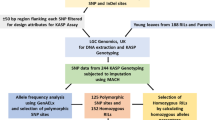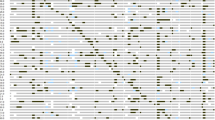Abstract
An advanced backcross breeding strategy was used to identify quantitative trait loci (QTLs) associated with eight agronomic traits in a BC2F2 population derived from an interspecific cross between Caiapo, an upland Oryza sativa subsp. japonica rice variety from Brazil, and an accession of Oryza rufipogon from Malaysia. Caiapo is one of the most-widely grown dryland cultivars in Latin America and may be planted as a monoculture or in a multicropping system with pastures. The objectives of this study were: (1) to determine whether trait-enhancing QTLs from O. rufipogon would be detected in 274 BC2F2 families grown under the drought-prone, acid soil conditions to which Caiapo was adapted, (2) to compare the performance with and without pasture competition, and (3) to compare putative QTL-containing regions identified in this study with those previously reported for populations adapted to irrigated, low-land conditions. Based on analyses of 125 SSLP and RFLP markers distributed throughout the genome and using single-point, interval, and composite interval mapping, two putative O. rufipogon derived QTLs were detected for yield, 13 for yield components, four for maturity and six for plant height.We conclude that advanced backcross QTL analysis offers a useful germplasm enhancement strategy for the genetic improvement of cultivars adapted to stress-prone environments. Although the phenotypic performance of the wild germplasm would not suggest its value as a breeding parent, it is noteworthy that 56% of the trait-enhancing QTLs identified in this study were derived from O. rufipogon. This figure is similar to the 51% of favorable QTLs derived from the same parent in crosses with a high-yielding hybrid rice cultivar evaluated under irrigated conditions in a previous study. In conclusion, parallel studies in rice using AB-QTL analysis provide increasing evidence that certain regions of the rice genome are likely to harbor genes of interest for plant improvement in multiple environments.
Similar content being viewed by others
Author information
Authors and Affiliations
Additional information
Received: 3 September 1999 / Accepted: 16 May 2000
Rights and permissions
About this article
Cite this article
Moncada, P., Martínez, C., Borrero, J. et al. Quantitative trait loci for yield and yield components in an Oryza sativa×Oryza rufipogon BC2F2 population evaluated in an upland environment. Theor Appl Genet 102, 41–52 (2001). https://doi.org/10.1007/s001220051616
Issue Date:
DOI: https://doi.org/10.1007/s001220051616




